Boxes / Desk
Boxes / Desk
Browse our collection of antique silver Boxes, Miniature Items, Inkstands and Desk Related Objects
Small Silver and Gold Boxes, Vinaigrettes, Snuff Boxes, Tea Caddies, Biscuit Boxes, Cases, Cigar Boxes, Speciality Boxes etc.
Since antique times caskets have been used to keep important documents and jewels. In England silver boxes (and gold) in a various of shapes and sizes became popular in the seventeenth century. Small boxes, designed for many diverse uses – counters, snuff, vestas, tobacco, vinaigrettes, scent, nutmeg, toothpicks, toilet boxes. Larger boxes, made for specific storage requirements, including tea, sugar, biscuits, cigarettes and cigars. The jewellery box remains as popular today as it did in ancient times.
Miniature Boxes, Dishes, Toys, Models, Kitchenware and Musical Instruments
Silver toys originated in Europe during the 17th century and were made initially for the children of kings and queens. At that time England was still suffering under Puritanism and it wasn’t until the Restoration of Charles II in 1660 that silver toys were made available in this country. The earliest English silver toys date from 1665 and were made in London; it was uncommon for toys to be made in the provinces. The Dutch were the leading manufacturers of silver toys, their most prolific period being 1725-1750, and by then wealthy royalty, landowners and business men were buying toys for their own pleasure as well as that of their children’s.
The Traveller’s Sample would be an exact copy of a full size original. The great attention to detail and slightly larger size than normal toys of this period generally indicates this purpose.
Inkstands and Inkwells. Desk Accessories, Bells, Pens, Letter Openers, Seals
The inkstand did not enter into common household use until the 18th century. Earlier 17th century examples exist but are exceedingly rare. The main requirement was a container for ink and another for sand (or pounce) which was used for drying the ink. Also required was a space to put quills. Some inkstands also incorporated a taper stick for melting sealing wax or even a bell.
Desk accessories form a wide and interesting collecting field and they make an excellent gentleman’s gift. It’s thought that the first handwritten letter was written, probably on canvas, by a Persian queen in around 500BC. Letters were vital for basic communication, both personal and formal, and were governed by basic rules of etiquette. The equipment required to write a simple letter was quite extensive including paper, envelope, pen, ink, blotter, stamps. Once written the letter or scroll needed to be sealed using a candle wax kit. Letter openers are useful gifts.
-

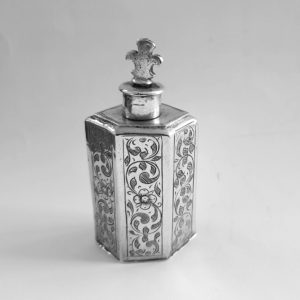
Circa 1580
10187 Elizabeth I Antique Silver Bottle
Sold
A fantastic little collector’s item. A rare 16th century silver bottle, tiny size, probably for perfume oil or holy water. The detachable screw top contains a space inside for either a cork or dip stick. The body is finely engraved with hatched ornament typical of the mid to late 16th century. Weight 20 grams. Height 6.5cm (to the top), 4.3cm (to top of body). Base measures 3.2cm x 2.2cm. English. Circa 1580. Unmarked silver.
-

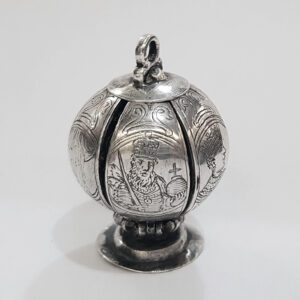
Circa 1600 - 1620
10349 17th Century Antique Silver Pomander
Sold
An intriguing piece of history contained in a small silver sphere. The antique silver pomander was worn round the neck or suspended from a belt and was intended to protect the wearer from sickness. The exterior of this example is hand engraved with royal portraits, probably English, based on engravings by Simon de Passe (c. 1595 – 6 May 1647). The screw top unturns to release six hollow, hinged segments to contain dried flowers, spices and scented oils. The interior is decorated with scroll and hatched engraving. A similar example formed part of the prestigious David Little collection. Weight 22 grams, less than 1 troy ounce. Height 3.9cm. Spread 5.6cm fully extended. Unmarked silver. Probably English. Circa 1600-20.
-

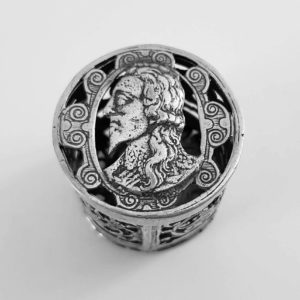
Circa 1635
Simon and Willem De Passe
9993 Charles I Antique Silver Box
Sold
A charming piece of early silver. An antique silver counter box of cylindrical form, the openwork sides pierced with fanciful birds and scrolling foliage. The cover has a bust portrait of Charles I, the base has a bust portrait of Henrietta Maria. This box has no counters.
-

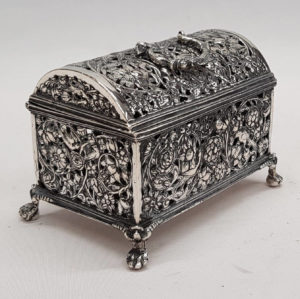
Circa 1660
9471 Antique Dutch Silver Marriage Casket
Sold
A rare 17th century silver wedding box “knottekistje” with a domed and hinged cover and swing handle. The pierced body has scrolling foliage, flowers and birds. Weight 268 grams, 8.6 troy ounces. Height 8.1cm. Length 10.2cm. Depth 6.3cm. Stamped underneath with the flower mark. Circa 1660. Maker unidentified.
-

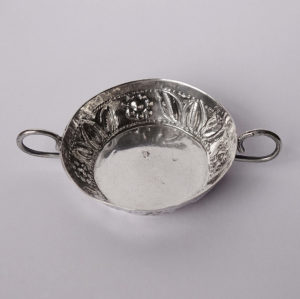
1665
William Goodwin
9117 Antique Charles II Miniature Silver Wine Taster
Sold
A rare early English toy wine taster in sterling silver from the reign of Charles II. Very sweet size. This little cup has a circular form with simple wirework handles and an embossed leaf and flower design. Weight 13 grams. Height 1.5 cm approx. Diameter of top 5 cms. Spread across handles 7.6 cms. London 1665. Makers mark “W.G” (see Jacksons page 123*), possibly William Goodwin free 1654, died 1703 (attribution by Dr David Mitchell “Silversmiths in Elizabethan and Stuart London”).
-

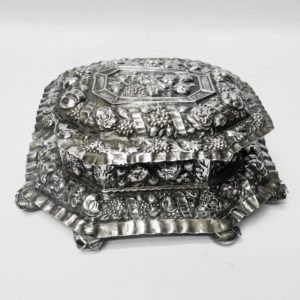
1669 - 1673
Johann Balthasar Sedletzky
9068 Antique German Silver Casket
Sold
A rare early Augsburg silver box of octagonal form with hinged lid and key. The silver is very thin gauge which is typical of early German silver and is heavily embossed with fruit and ribbon design. The base plate still has the original fasteners. Weight 266 grams, 8.5 troy ounces. Height 7.3 cms. Base 16.5 x 13.5 cms. Stamped on the edges and underneath with German silver marks for Augsburg. Makers mark IBS for Johann Balthasar Sedletzky. Circa 1669-73.
-

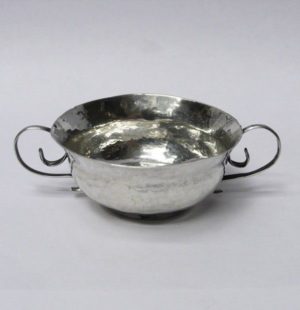
Circa 1670
8131 Charles II Miniature Silver Wine Taster
Sold
A rare early English toy two-handled wine taster in sterling silver from the reign of Charles II. With a simple plain form and wirework handles. This little cup has an excellent patina and hammered finish. Contains 10 ml approx. Weight 12 grams. Height 2 cms. Diameter of top 4.5 cms. Spread across handles 6.7 cms. Marked underneath with the makers mark only “WH conjoined, mullet below”. Mark entered 1670 (see Jacksons page 130*).
-

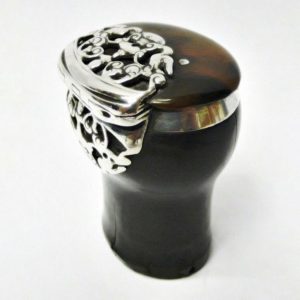
Circa 1671
8260 Antique Silver Snuff Mull
Sold
A charming antique silver mounted horn snuff box having a rising lid with an elaborate silver strapwork hinge and a silver band around the top edge. Attractive waisted shape. Height 6 cms. Top measures 4 x 3.7 cms. Unmarked silver. Most probably Scottish. Underneath there is the incised date “1671” which is probably the original date.
-

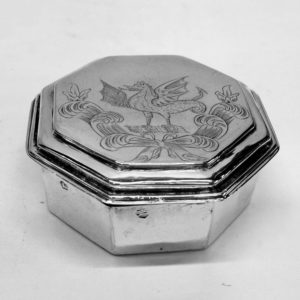
1675
Isaac Dighton
9172 Charles II Antique Silver Boxes
Sold
A very rare matching pair of early antique silver boxes of octagonal form, with pull off tops, dating from the reign of King Charles II. Sterling silver. Simple plain form with a large hand engraved crest within tied plumage, very typical of the date. Superb antique colour. At this date boxes of this type would have originally been part of an extensive toilet service. Total weight 239 grams, 7.6 troy oz. Height 3.5cm. Width of top 9cm. London 1675. Maker Isaac Dighton, London.
-

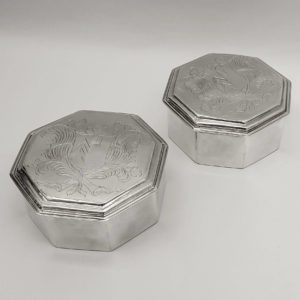
1675
9572 Antique Charles II Silver Boxes
Sold
A very rare matching pair of early antique silver boxes of octagonal form, with pull off tops, dating from the reign of King Charles II. Good size and weight. Sterling silver. Simple plain form with a large hand engraved armorial within tied plumage feathers, very typical of the date. Superb antique colour. At this date boxes of this type would have originally been part of an extensive toilet service. Total weight 645 grams, 20.7 troy ounces. Height 6.3 cm. Width of top 12.7/13.5 cm. London 1675. Maker’s mark “B” – see Jackson’s page 133.
-

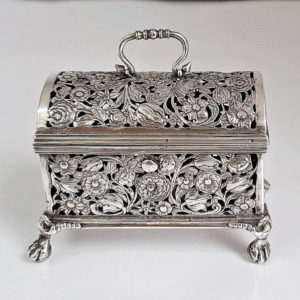
Circa 1680
9724 Antique Dutch Silver Marriage Box
Sold
A 17th century silver casket of traditional rectangular trunk form having a domed top with swing handle. The openwork cast body is smothered in flower heads and scrolling foliage. Bold flowers, including poppies, tulips and daffodils were very popular during the mid to late 17th century. The hand chasing is excellent. The body stands on four little ball and claw feet and has a front locking catch. Weight 159 grams, 5.1 troy ounces. Height 6.6cm (7.5cm with handle extended). Length 8.2cm. Depth 5cm. Stamped inside on the base twice with a maker’s mark (bird?) unidentified. Dutch. Circa 1680.
-

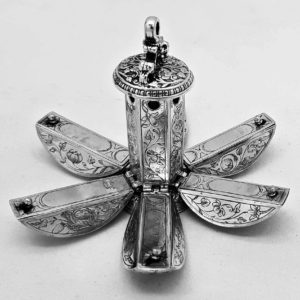
Circa 1680
9855 17th Century Continental Silver Pomander
Sold
A fascinating piece of history contained in a small silver globe. This antique silver pomander of spherical form has all-over chased decoration of flowers & leaf-scrolls in low relief. The screw top unturns to release the six numbered, hinged segments with sliding covers, the interior with hand engraved flowers. The foot unscrews to reveal a secret hollow compartment. Weight 89 grams, 2.8 troy ounces. Height 6.5cm. Spread 9cm fully extended. The pomander is made of unmarked silver It is quite usual for a small article of this date to be unmarked. Probably Dutch. Circa 1680.
-

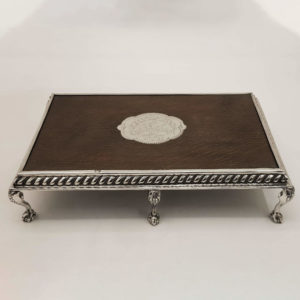
Circa 1680
10325 Antique Silver Table Trivet
Sold
An unusual 17th century miniature table of rectangular form standing on cabriole legs. A perfect display for a small tea set or pair of candlesticks. The solid wood top, with inset armorial plaque, is mounted with a silver framework. The underside still has the original claws to hold the wood in place and the pretty little wing nuts for the silver plaque; the remains of an old collector’s label can be seen in the corner. Top measures 26.2cm x 16.4cm. Height 6.3cm. Maker “GJ”. English, circa 1680. Provincial silver. Probably East Anglian.
-

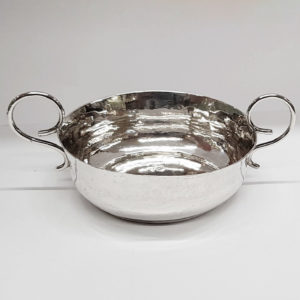
1683
Samuel Hawkes
9523 Charles II Silver Wine Taster
Sold
A rare early English two-handled wine taster in sterling silver from the reign of Charles II. With a simple plain form and wirework handles. Excellent patina and faint signs of the hand hammered finish. Owners initials inscribed underneath. Weight 27 grams, just under 1 troy ounce. Height 2.2 cm (bowl), 3.5 cm (to top of handle). Diameter of top 6.5 cm. Spread across handles 9.2 cm. London 1683. Maker’s mark “SH” within a heart shaped shield, probably Samuel Hawkes (*see David Mitchell’s book on “Silversmiths in Stuart and Elizabethan England”).
-

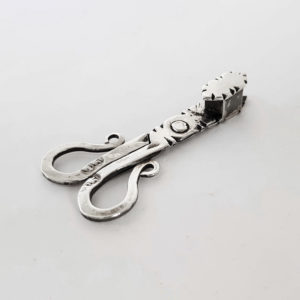
Circa 1685 - 1720
George Manjoy
9764 Antique Silver Miniature Candle Snuffers
Sold
A delightful little collector’s piece. A rare antique silver wick trimmer miniature, also called a candle douter. Britannia standard silver*. Weight 6 grams, 0.19 troy ounces. Length 4.8 cm. Width 2.2 cm. Circa 1700. Maker George Manjoy (c.1685-c.1720), specialist toy maker (see Jackson’s Silver & Gold Marks of England, Scotland & Ireland p.141).
-


1686
10450 James II Antique Silver Chamberstick
Sold
A distinctive little chamberstick (or “go to bed”) with the solid design and heavy gauge silver you’d expect from this date. It has the early form with a flat teardrop handle engraved with a family coat of arms. The circular pan has a gadrooned border and ribbed sconce, all mounted on three small stump feet. Weight 187g, 6 troy oz. Height 4.3cm. Diameter 9.7cm. Spread 15cm, 5.9ins. London 1686. Maker’s mark unclear. Sterling silver.
-

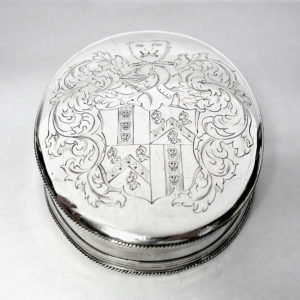
1688
8877 Antique James II Silver Tobacco Box
Sold
A rare early English sterling silver box with lift off top. Simple oval shape and rope borders. This style was popular from the mid 17th century up until the reign of George I. The top has a large hand engraved coat of arms within a decorative cartouche. Weight 120 grams, 3.8 troy ounces. Length 9.2 cms. Width 7.4 cms. Height 2 cms. London 1688. Maker “RH” – see Jacksons page 143*.
-

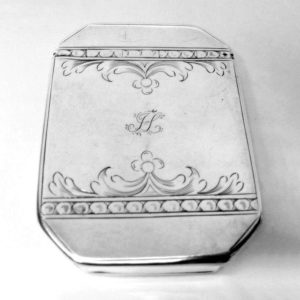
Circa 1690
Elizabeth Haslewood
8255 Antique Norwich Silver Box
Sold
A rare early antique silver snuff box from the provincial city of Norwich. Attractive rectangular octagonal form with hinged lid hand engraved with a scroll design and initials “JL”. Excellent silver patina. Original gilt interior with a deep colour. Weight 63 grams, 2 troy ounces. Height 1,1 cms. Top 7.25 x 5.25 cms. Marked inside the base with initials for the Norwich lady silversmith Elizabeth Haslewood. Makers mark only, circa 1690.
-

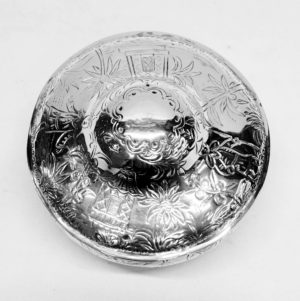
Circa 1690
9150 Antique Silver Chinoiserie Box
Sold
A rare little early antique silver trinket box with a pull off lid and original gilt interior. The engraved decoration is very charming with Chinese figures, pagodas and garden scenes. Weight 141 cm, 4.5 troy ounces. Height 6 cm. Diameter 9.5 cm. Stamped underneath with a crown and 3 stars over the makers initials “LM”. European, possibly English, circa 1690.
-

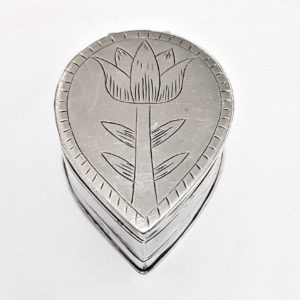
Circa 1690
Mary Elliott
9630 William & Mary Antique Silver Nutmeg Grater
Sold
A William and Mary teardrop shape silver nutmeg grater with steel rasp. With a hinged lid either side. One lid is engraved with a tulip flower, the other has no engraving. Weight 37 grams, 1.1 troy ounce. Height 2 cm. Top 4.2 x 3 cm. Spread across the hinge 4.5 cm. Stamped inside of the lids with makers mark only “ME” conjoined between pellets, bird above, cinquefoil below, in lozenge shaped widow’s shield. Probably Mary Elliott. Circa 1690. Mark references Jackson 1989 p.144.04, David Mitchell “Silversmiths in Elizabethan and Stuart London”
-

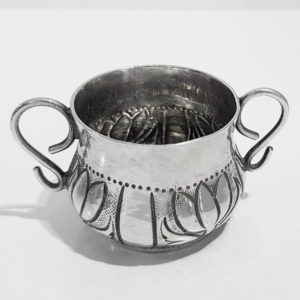
Circa 1690
9638 William & Mary Antique Silver Miniature Porringer
Sold
A delightful little collector’s piece. A charming little antique silver cup with two side handles and the tulip decoration typical of the William & Mary period. The body has a border of hand chased fish scale and impressed tulip ornament, the base also has the tulip design within a prick dot circle. This is an exact copy of a full size original. Weight 30 grams, 1 troy ounce. Height 3.3cm, 3.6cm to top of handles. Spread 6.3cm. Diameter 4cm. Unmarked. No makers mark. English. Circa 1690.
-

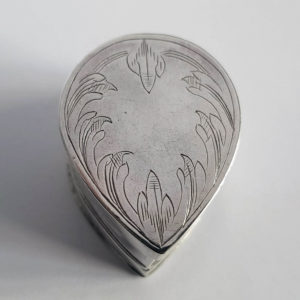
1690
9997 William & Mary Antique Silver Nutmeg Grater
Sold
A charming little late 17th century silver nutmeg grater of teardrop form, one side fitted with a serrated rasp. Each side has a hinged lid with stand-away hinge. Both covers are hand engraved with simple foliate decoration. Weight 29 grams, 0.9 troy ounce. Height 2.5 cm. Top 3.7 x 2.9 cm. Total spread across the covers 8.3cm. Unmarked silver. English. Circa 1690.
-

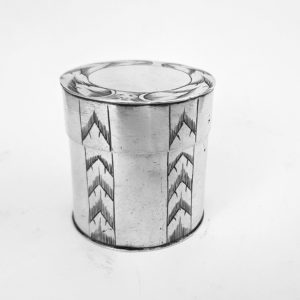
Circa 1690
10151 17th Century Antique Silver Counter Box
Sold
A late 17th century silver counter box of typical cylindrical form with pull-off cover. The lines of hatched engraving resemble that on English silver nutmeg graters circa 1690 and there is a small comical face showing through the border on the lid. Weight 44 grams, 1.4 troy ounces. Height 4.3cm. Diameter 4,.2cm. Unmarked silver. Probably English. Circa 1690.
-

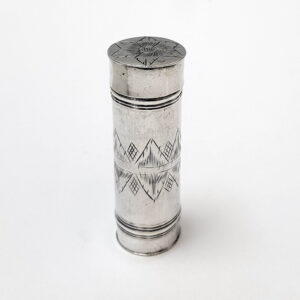
Circa 1690
10333 17th Century Antique Silver Nutmeg Grater
Sold
An attractive little collector’s item. A silver nutmeg grater of cylindrical form, the tube containing a steel grater. The pull off lid is hand engraved with the Tudor rose and the tube has the hatched decoration typical for small silver objects dating back to the final quarter of the 1600’s. Silver weight 14g, about half a troy oz. Length 6.1cm. Diameter 2cm. Maker mark I.I. English circa 1690. Sterling silver.
-

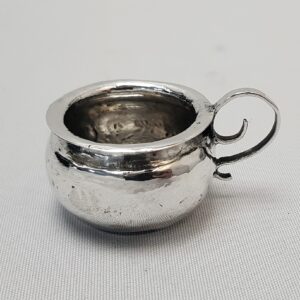
Circa 1690
Charles Eystone
10394 William & Mary Antique Silver Miniature Chamber Pot
Sold
A charming little doll’s house piece. This rare miniature antique silver potty is made of hand beaten sheet silver with a simple scrolled handle. It dates to the second half of the 1600’s. Weight 13g, less than half a troy oz. Spread 4.9cm. Diameter 3.4cm. Height 2.5cm (to top of handle). London, circa 1690. Maker Charles Eystone. Sterling silver.
-


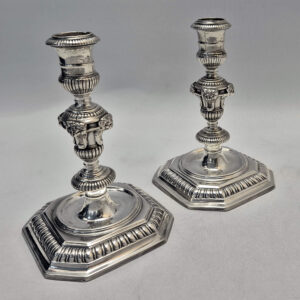
1694
John Laughton
10432 William III Antique Silver Candlesticks
Sold
A superb pair of early English desk candlesticks with square bases and lobed, gadroon decoration. The applied lion masks are extremely charming. The technique of making cast silver sticks was introduced into England circa 1685 and this is one of the early designs. Excellent quality and heavy gauge of silver. Total weight 750g, 24.1 troy oz. Height 15.5cm. Base 10.7cm. London 1694. Maker John Laughton. Sterling silver. 17th century.
-

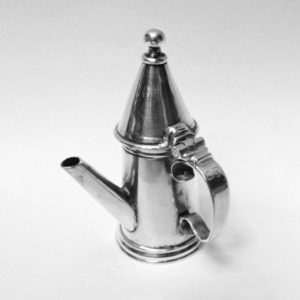
Circa 1695
8202 Antique William III Miniature Silver Coffee Pot
Sold
A charming little antique silver toy coffee pot. This beautiful little side handle pot has a cylindrical tapering body, a conical lid surmounted by a ball finial, and a low spout akin to those more usually found on a chocolate pot. Engraved to the upper handle are the owner’s initials “C.P”. The pot looks like an exact copy of a full size original and the great attention to detail and slightly larger size than normal toys of this period indicate that it may well have been a traveller’s sample. Contains 20 ml. Weight 60 grams, 1.9 troy ounces. Height 8 cms. Spread 5 cms. Diameter of base 3.5 cms. Marked on the body with makers mark only “WP”* – noted for making toy cups and porringers (see Jacksons Welsh and Unascribed English Provincial section, page 521). Circa 1695.
-



1695
John Laughton
10433 William III Antique Silver Candlesticks
Sold
A superb pair of early English desk candlesticks with square bases and lobed, gadroon decoration. The applied lion masks are extremely charming. The technique of making cast silver sticks was introduced into England circa 1685 and this is one of the early designs. Excellent quality and heavy gauge of silver. Total weight 750g, 24.1 troy oz. Height 15.5cm. Base 10.7cm. London 1695. Maker John Laughton. Sterling silver. 17th century.
-

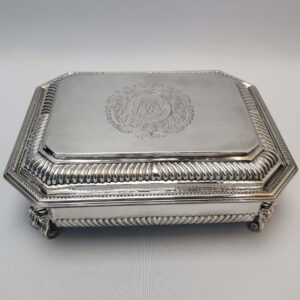
1697
Joseph Ward
10402 William III Antique Silver Casket
Sold
A substantial early English silver box of plain rectangular form, having canted corners and broad gadrooned banding. Very rare. Excellent size. The top has a large hand engraved cartouche containing a decorative cypher. Weight 1133g, 36.4 troy oz. Top measures 25cmx18.5cm. Height 8.5cm. London 1697. Maker Joseph Ward. Britannia standard silver, 95.8% pure.
-

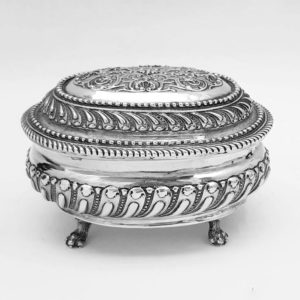
Circa 1700
9593 Antique German Silver Box
Sold
An antique continental silver box with detachable lid and standing on animal’s paw feet. The box has ribbed detail with gadroon and bead borders, the lid with shell and classical motifs. Weight 256 grams, 8.2 troy ounces. Height 9 cm. Top 13.2 x 9.5 cm. Stamped with German silver marks for Augsburg. Circa 1700.
-

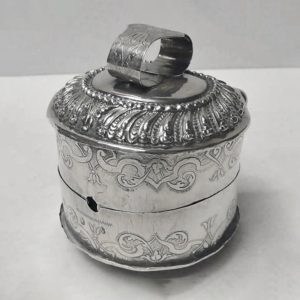
1701 - 1799
8439 Early Continental Silver Bougie Box
Sold
An unusual antique silver wax jack, or taper holder, with cut card work and flower decoration to the body. The wax coil would have been contained inside the drum shaped box. Weight 103 grams, 3.3 troy ounces. Height 8.5 cms. Width 7.5 cms (excluding handle). Diameter 7 cms. Marked on the front with an assay scrape, Nuremberg mark and makers mark. 18th century. German.
-

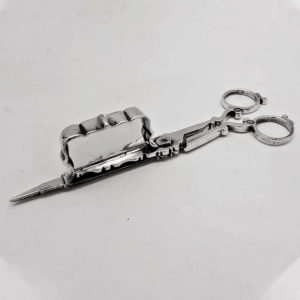
1701
Thomas Brydon
10371 William III Silver Snuffer Scissors
Sold
A rare early English silver candle douter, also called a wick trimmer, with the simple plain style typical of the period. *Britannia standard silver. Weight 94 grams, 3 troy ounces. Length 15.9cm. Width 5.5cm. London 1701. Few snuffers were made prior to 1700. Maker Thomas Brydon, see Jackson’s Silver & Gold Marks page 154, a known snuffers and stand maker.